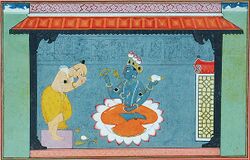Biology:Vaijayanti
| Vaijayanti | |
|---|---|
 Vishnu wears the garland, seated upon Garuda | |
| Venerated in | Vaishnavism |
| Texts | Vishnu Purana |
The Vaijayanti lit. "the garland of victory"[1] is a mythological garland or elemental necklace, primarily associated with Vishnu.[2] Employed in its worship as a garland, this object is also called the Vaijayantimala or the Vanamala.[3][4]
Literature
Vaijayanti finds a mention in Vishnu Sahasranama, a stotram dedicated to Vishnu in the Mahabharata, as vanamali (forest flowers).[5]
The garland of victory is mentioned in the Mahabharata, as made of never-wilting lotuses.
| Part of a series on |
| Vaishnavism |
|---|
 |
In the Skanda Purana, Varuna presents Lakshmi with the garland as a wedding gift.[6]
According to the Vishnu Purana, the garland prominently displays five precious gemstones: emerald, sapphire, ruby, pearl, and diamond. These correspond with the five classic elements commonly named earth, water, fire, air, and ether respectively.[5][7]
In the Shiva Purana, Vishnu offers his garland to his son-in-law Kartikeya, before his battle with the asura Taraka.[8]
The Garuda Purana includes a prayer known as the Vishnu Panjaram, which includes the following verse: "Taking up Vaijayanti and Srivatsa, the ornament of thy throat do thou protect me in the north-west, O god, O Hayagriva. I bow unto thee".[9]
See also
References
- ↑ D Dennis Hudson (27 August 2008). The Body of God Emperor's Palace for Krishna in Eighth-Century Kanchipuram: An Emperor's Palace for Krishna in Eighth-Century Kanchipuram. Oxford University Press. pp. 168–. ISBN 978-0-19-970902-1. https://books.google.com/books?id=IMCxbOezDi4C&pg=PA168.
- ↑ www.wisdomlib.org (2016-04-25). "Vaijayanti, Vaijayantī, Vaijayamti: 19 definitions" (in en). https://www.wisdomlib.org/definition/vaijayanti.
- ↑ Prof. Shrikant Prasoon (17 February 2014). Hinduism Clarified and Simplified. V&S Publishers. pp. 235–. ISBN 978-93-81384-72-5. https://books.google.com/books?id=wpiaOv52wp0C&pg=PA235.
- ↑ Rūpagosvāmī (2003). The Bhaktirasāmṛtasindhu of Rūpa Gosvāmin. Motilal Banarsidass. pp. 575–. ISBN 978-81-208-1861-3. https://books.google.com/books?id=DsRb6gjUa1oC&pg=PA575.
- ↑ 5.0 5.1 V. Ravi (30 November 2012). Vishnu Sahasranama. MANBLUNDER. p. 248. GGKEY:DRA5CW5BDZX. https://books.google.com/books?id=G02pZ6u3Rw4C&pg=PA248.
- ↑ www.wisdomlib.org (2020-03-05). "The Marriage Festival of Lakṣmī and Nārāyaṇa [Chapter 14"] (in en). https://www.wisdomlib.org/hinduism/book/the-skanda-purana/d/doc371753.html.
- ↑ www.wisdomlib.org (2014-08-30). "Dominion over different provinces of creation assigned to different beings [Chapter XXII"] (in en). https://www.wisdomlib.org/hinduism/book/vishnu-purana-wilson/d/doc115958.html.
- ↑ www.wisdomlib.org (2018-10-14). "Kārttikeya is crowned [Chapter 5"] (in en). https://www.wisdomlib.org/hinduism/book/shiva-purana-english/d/doc226125.html.
- ↑ www.wisdomlib.org (2015-04-12). "The prayer of Vishnu Panjaram [Chapter XIII"] (in en). https://www.wisdomlib.org/hinduism/book/the-garuda-purana-dutt/d/doc122487.html.


